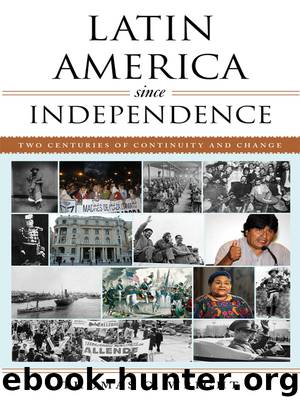Latin America Since Independence by Wright Thomas C

Author:Wright, Thomas C.
Language: eng
Format: epub
ISBN: 9781442235724
Publisher: Rowman & Littlefield Publishing Group, Inc.
RECONSTRUCTION AND GRADUALISM, 1917–1934
Between the constitution’s adoption in 1917 and the presidency of Lázaro Cárdenas (1934–1940), progress on carrying out the promised revolution was slow. Carranza, the old Porfirian, was not enthusiastic about the document he did not want but was forced to accept. Thus during his formal presidency (1917–1920), little changed. His successor was colorful revolutionary General Álvaro Obregón, who lost an arm in the fighting and proclaimed that people preferred him over other politicians because with a single arm, he could not steal as much as they. Obregón was more open than Carranza to implementing the constitution but did so cautiously, for two main reasons. First, he reasoned that Mexico’s reconstruction should be his priority, and that disruption of the economy through rapid dismantling of the haciendas or excessive benefits to labor would impede recovery from the destruction caused by years of warfare. Second, with two recent U.S. military invasions fresh in Mexicans’ memory, the U.S. business lobby’s loud and persistent calls for intervention to prevent implementation of the constitution’s antiforeign provisions counseled prudence. Yet, Obregón made a start. Under Secretary of Education José Vasconcelos, a thousand rural schools were built and two thousand public libraries were opened. With Obregón’s support, Mexico’s first major national labor union, the Confederación Regional Obrera Mexicana (Regional Confederation of Mexican Workers, CROM), expanded its membership and gained considerable political and bargaining power. Implementing article 27, Obregón distributed three million acres to over six hundred villages.
Obregón’s successor, Plutarco Elías Calles, was another general risen through the ranks during the civil wars. He held office for four years (1924–1928) as prescribed by the constitution; but having built a powerful political machine, he named and controlled three short-term presidents who followed him between 1928 and 1934. During his own presidency, he built upon and accelerated Obregón’s beginnings at reform, distributing some eight million acres of land, opening two thousand rural schools, and supporting the growth of the CROM. At his direction, however, progress on the promised revolution slowed under his three puppet presidents. In 1929, Calles engineered the unification of all the revolutionary generals who controlled various parts of the country under the umbrella of the Partido Nacional Revolucionario (National Revolutionary Party, PNR).
Whereas Carranza and Obregón had largely ignored the constitution’s anticlerical provisions, Calles began implementing them, stepping up the deportation of foreign priests and the closing of monasteries and religious schools. He also tolerated the more sweeping measures taken by Tabasco state governor Tomás Garrido Canabal, who was not only anticlerical but antireligious. Garrido closed and looted churches, removed crosses from graves, and required all priests in his state to marry, which the Catholic Church prohibited. On his farm, he had a hog named the Pope, a donkey named Christ, a cow named the Virgin of Guadalupe, and a bull named God. English author Graham Greene’s acclaimed novel The Power and the Glory portrays Tabasco under this purge of all traces of religion.
Calles’s and Garrido’s measures elicited a response from the archbishop of Mexico
Download
This site does not store any files on its server. We only index and link to content provided by other sites. Please contact the content providers to delete copyright contents if any and email us, we'll remove relevant links or contents immediately.
Cecilia; Or, Memoirs of an Heiress — Volume 1 by Fanny Burney(32068)
Cecilia; Or, Memoirs of an Heiress — Volume 3 by Fanny Burney(31463)
Cecilia; Or, Memoirs of an Heiress — Volume 2 by Fanny Burney(31413)
The Great Music City by Andrea Baker(30794)
We're Going to Need More Wine by Gabrielle Union(18641)
All the Missing Girls by Megan Miranda(14767)
Pimp by Iceberg Slim(13787)
Bombshells: Glamour Girls of a Lifetime by Sullivan Steve(13692)
Fifty Shades Freed by E L James(12923)
Talking to Strangers by Malcolm Gladwell(12887)
Norse Mythology by Gaiman Neil(12847)
For the Love of Europe by Rick Steves(11545)
Crazy Rich Asians by Kevin Kwan(8894)
Mindhunter: Inside the FBI's Elite Serial Crime Unit by John E. Douglas & Mark Olshaker(8708)
The Lost Art of Listening by Michael P. Nichols(7169)
Enlightenment Now: The Case for Reason, Science, Humanism, and Progress by Steven Pinker(6878)
The Four Agreements by Don Miguel Ruiz(6324)
Bad Blood by John Carreyrou(6283)
Weapons of Math Destruction by Cathy O'Neil(5842)
